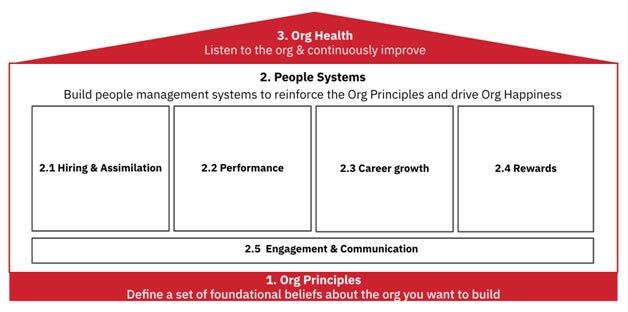If you are a startup founder, there would be many questions that keep you up at night, none more so than “How do I build an org that delivers great business outcomes and has a culture that I can be proud of?” The environment of a rapidly scaling startup is especially challenging to org building: the ambitions and opportunities are immense; the team to execute them is relatively small; and at any time, it seems like there are more open positions than people in the company! So how do you go about building a high performing org with great culture at a startup? Read on to find out!
Org Health: What are your teams saying?
Perhaps the best way to capture the need to pay close attention to your org health and people systems to support it is in these first-hand comments we have heard through surveys of >3,000 startup employees and first-hand conversations with >500 people:
- “A sense of pride in working here is a big contributor to driving energy in the organization”
- “I feel that my role is significant in the org and what I am doing is going to have a long lasting impact”
- “I look forward to coming into work everyday because I work with a set of smart people with whom I can freely exchange ideas”
- “We need to evolve from whatsapp based work and ‘1st to respond’ ownership towards clearer accountability and decision making”
- “We have not defined values and culture clearly for the organization, and hence we do not have practices in order to preserve them either”
Design the Org you want
Your org is the biggest product that you are building – this statement comes as a revelation and a relief to many of the startup CEOs we have talked to. A revelation because they hadn’t quite seen it that way, a relief because it moves org building out of the hazy realm of culture and behaviour theory into the domain of PRDs and product features that they are more familiar with. There are three big reasons you should think of your org as your biggest ‘product’ and design it accordingly:
- Culture is self-forming: When a group of people interact, some type of culture “happens” – whether you want it or not. Better to design what you want, rather than try to change what has happened organically!
- Values are sticky: Business model pivots are sometimes done overnight, but the values and ways of working are much more difficult to change. So getting the design right early is important.
- Real competitive advantage, difficult to copy: It might be easy for the competition to catch up to your product features (eventually), but copying the recipe for your org is near impossible. If done well, this can be a lasting source of competitive advantage.
Org Building: A how-to guide

Building an org is a lot like building a house as depicted in Exhibit 1. You lay the foundation by defining Org Principles describing the type of org you want to build and the ways of working. Next come the People Systems – the pillars and structures that hold up your org and make it tick. These are the practices, policies and processes that are followed in the org. These processes hold up the roof – your Org Health or Culture. This forms the most visible part of the house – day to day behaviours, the perceptions others have about your company and your reputation in the talent market!
Put simply, you can thoughtfully design the org you want to build (much like your product), or you can let your org design itself! If you are convinced about the need to thoughtfully design and build the org you want, then you can start writing the PRD for your org – the “Manifesto”.
1. Writing your Org Manifesto
The Org Manifesto is a document that defines the core values of your org, how people work together, your approach to talent management and what your employee value proposition is. There are no hard and fast rules about what goes in your Org Manifesto. It is, after all, your personal vision for the org you want to build. But a few questions you can answer to help you get started on your manifesto:
- What are your most deeply held personal beliefs? Why do you exist as a company? Your org is a reflection of you, hence if you don’t believe something deeply enough, your org is never going to reflect it.
- What is the current value system and the existing norms for behaviour in your org? You can add a few ‘aspirational’ values, but try to limit those to 1-2, call them out and why you want to change (you can’t become something you are not!)
- What are principles that you want to be broadly embraced by all parts of your org, be it Tech or Ops or Business? You want some common threads holding together the entire org cohesively, even when individual departments have their distinct subcultures.
How is the Manifesto used?
- For the org, the Manifesto guides every design decision to be made on people design and ensure coherence across the various systems, practices and processes the org is following.
- For existing employees, it provides a sense of pride in the org they are contributing to and acts as a northstar for all decision making where no rules exist
- For incoming employees, the manifesto provides a way for understanding the org’s ways and culture deeply, even before joining
2. People Systems Design
Going back to our house analogy, People Systems form the pillars of your org. Just like pillars hold up the roof of a house and anchor it to the foundation, so do your people systems hold up your org culture and tie them to your vision for the org. They do this because systems have the power to reinforce the right behaviours into culture. For example, if you want to build a culture of risk-taking, systems that look for this trait at hiring, and identify and reward it during performance assessment will ensure that over a couple of cycles, you have an org that has a risk-taking DNA. Conversely, if your people systems don’t match your Org Principles, they will forever remain “on the walls” not “in the halls”!
There are five key components of an org’s people systems:
- Hiring and assimilation: The engine that hires and onboards at scale without lowering the bar
- Performance Management:Aligns people towards common goals and provides data to take key people decisions e.g.: Rewards, Promotions & Opportunities
- Rewards Philosophy: Define how you will reward employees (e.g., company vs. team vs. individual)
- Career Growth: Creates high-impact roles and opportunities for growth for top talent
- Engagement & Communication: Aligns the entire org on “who we are and where we’re going”; provides a channel to share stories and hear from every single person in the org
There are several choices to be made in each system, such as: Hiring for experience vs. intrinsics; Performance assessment based on inputs vs outputs, Cash vs. Stock rewards (for short-term impact vs. long-term contributions and potential). The core principle is to make sure each of these reflect the principles outlined in the manifesto. The “how-to” guides for each is the subject of future articles!
3. Measure and continuously improve your Org Health
Like any good product, the org you are developing needs continuous data-driven measurement, monitoring and improvement. Listening to your employees, understanding their engagement levels and what drives them gives you inputs on what is working and what you need to change. Based on ~3000 employees across startups who have taken our “10xPeople” survey so far, here are some interesting initial insights we have gathered on what drives employee engagement in the startup ecosystem:
- Sense of pride in association with the organization (Employees with low sense of pride have an eNPS of – 87)
- High trust teams (Low trust teams have an eNPS of – 47)
- Meaningful roles with opportunity to create impact (Lack of a meaningful role leads to an eNPS of -64)
- Fair reward practises (Employees who feel they are not being rewarded fairly have an eNPS of – 14)
- Decision-making process (Employees who feel we don’t have an efficient decision-making process have an eNPS of -26.5)
In summary…
Your org is the biggest product you will build and approaching it with the same rigour as your customer facing products will help you build an org that achieves big strategic goals and embodies a culture you can be proud of. As the founder, you can start by designing the Manifesto – this is the ‘PRD’ for your org and the people practices and systems will flow from here. And lastly, just like you would with your customers, listen to the org frequently and continuously evolve it towards greatness.
We would like to thank Mekin Maheshwari (CEO of Udyam and ex-Chief People Officer at Flipkart) and Naveen Tiwari (Founder & CEO at InMobi) for their invaluable contributions to this article.



